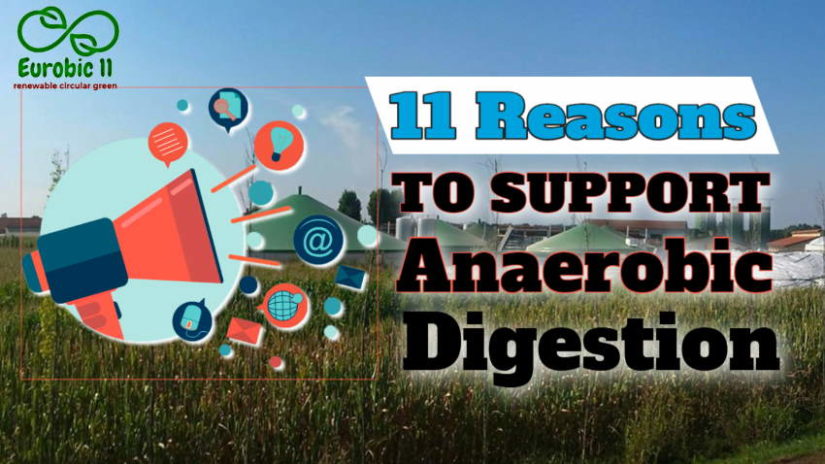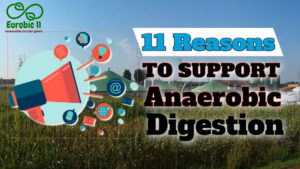
Promote Anaerobic Digestion to Support the Industry
Our mission is for our team of authors to support the technology of anaerobic digestion which produces biogas – a renewable energy source which uses short cycle carbon which is replaceable through cultivation.
Why Did You Choose to call yourselves the Eurobic 11?
We called the site Eurobic 11 because we are a group of 11 Europeans and we promote anaerobic technology!
List of Our Anaerobic Digestion and Biogas Advantages
The following is our list of anaerobic digestion and biogas advantages:
- Produces a genuine renewable energy
- Can start today to reduce global carbon emissions by about 12% (World Biogas Association estimate) by 2030.
- The technology is proven and can only get better as more AD plants are built and investment rises.
- It provides a healthy way to dispose or treat waste organic matter, especially for food waste and agricultural wastes such as manure, chicken litter etc. In so doing organic matter is diverted away from landfill where it sits and creates a risk of pollution should it ever leak out of a landfill into he surrounding ground or watercourses.
- The output contains nutrients which can reduce the demand for chemical fertilisers which themselves require the consumption of non-renewable energy sources.
- The process can effectively recycle phosphor and nitrogen reducing the toxic effects of nitrogen and the current emission of unnatural levels of phosphorus into the environment.
- The biogas can be used as a stop gap energy until more advanced technologies such as cheap batteries (using sustainable renewable materials i.e. not rare earth metals), hydrogen powered cars etc. are developed.
- The biogas can be upgraded to biomethane which is equivalent to, and has all the uses of natural gas while being renewable and thus sustainable.
- Biogas can be used to power heavy goods vehicles and diesel vehicles in cities to reduce air-pollution.
- The technology requires engineers and other staff to run the facilities – which creates skilled and rewarding jobs. The facilities are by their nature distributed geographically to utilise the local organic (biomass) available to feed each plant. Therefore, many of the jobs created are in rural areas.
- The output (known as digestate) contains a fibrous content which can be heated to become carbon char. Carbon char, which when added to agricultural soils depleted of all but their mineral content by heavy use of chemical fertiliser:
- repairs the soil structure for increased crop growth, allowing it to hold back more water after rainfall and need less irrigating in dry weather
- sequestrates carbon in the ground acting as a carbon sink to help reduce the carbon dioxide “greenhouse gas” in the earth’s atmosphere
- as a result of that helps to reduce climate change.
 Once people understand these multiple advantages of anaerobic digestion and biogas production global governments will truly be forced to assist the biogas industry globally to acheive the amazing potential of this age old fermentation technology.
Once people understand these multiple advantages of anaerobic digestion and biogas production global governments will truly be forced to assist the biogas industry globally to acheive the amazing potential of this age old fermentation technology.
Those were our 11 advantages of this awesome technology which is anaerobic digestion and biogas!
These are the Eurobic 11 benefits of anaerobic digestion and biogas technology!
FAQs About the Reasons to Support Anaerobic Digestion
Q1: How Does Anaerobic Digestion Benefit Renewable Energy?
A: It produces biogas, a renewable energy source, reducing reliance on fossil fuels.
Q2: What Types of Waste Can Be Treated with Anaerobic Digestion?
A: Various organic wastes, including food waste, manure, and agricultural residues, can be treated.
Q3: How Does Anaerobic Digestion Impact Carbon Emissions?
A: It reduces greenhouse gas emissions by capturing methane and replacing fossil fuels.
Q4: Can Anaerobic Digestion Support Rural Job Creation?
A: Yes, it can create jobs in rural areas through the construction and operation of biogas plants.
Q5: What is the Role of Anaerobic Digestion in Soil Restoration?
A: The digestate output flow produced enhances soil fertility and aids in carbon sequestration.

